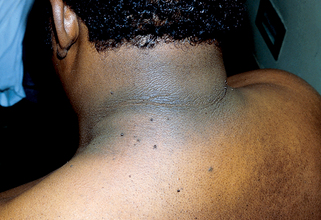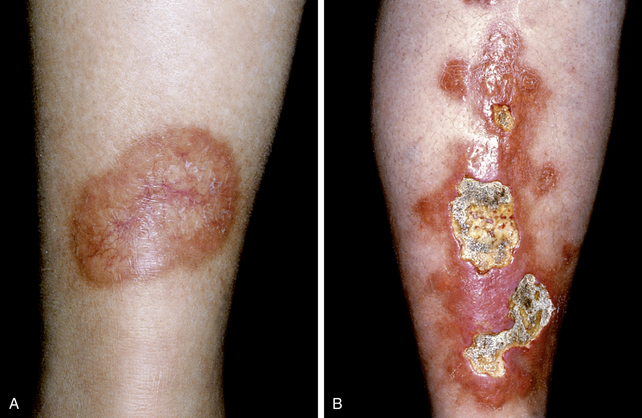Chapter 36 Cutaneous manifestations of endocrinologic disease
1. How does endocrinologic disease cause skin disorders?
There are several mechanisms by which endocrinologic diseases produce cutaneous changes:
• Hormones interact with cell surface receptors to regulate cellular function. Many cell types in the skin have hormonal receptors. Deficient or excess hormone levels can alter skin metabolism. An example is the warm and moist skin associated with hyperthyroidism due to the thyroid-stimulating hormone (thyrotropin, TSH) receptors in the skin.
2. What is necrobiosis lipoidica?
This disease is characterized by granulomatous inflammation and fibrosis with a marked predilection to occur on the pretibial areas, although it may occur at other sites. Early lesions present as nondiagnostic erythematous papules and evolve into annular lesions that have a yellowish-brown color, dilated blood vessels, and central epidermal atrophy (Fig. 36-1). Fully developed pretibial lesions can be diagnosed by clinical appearance.
3. Do all patients with necrobiosis lipoidica have diabetes?
No. In a study of 171 patients with necrobiosis lipoidica, about 60% had diabetes. Many other patients subsequently developed diabetes, had abnormal glucose tolerance tests, or had a strong family history of diabetes. Only about 10% of patients were not in a high-risk group to develop diabetes. In a more recent study with 65 patients, 22% either had or developed diabetes. Patients with necrobiosis lipoidica should be screened for diabetes.
Peyrí J, Moreno A, Marcoval J: Necrobiosis lipoidica, Semin Cutan Med Surg 26:87–89, 2007.
4. Is necrobiosis lipoidica diabeticorum common in patients with diabetes?
5. Does glucose control affect necrobiosis lipoidica diabeticorum?
6. What other skin findings are associated with insulin resistance?
Acanthosis nigricans. Insulin-like growth factors are produced by the liver in response to high levels of circulating insulin. These growth factors bind to epidermal growth factor receptors or other receptors and produce thickening of the epidermis and hyperkeratosis. Acanthosis nigricans can be found in 30% to 50% of patients with diabetes and correlates with obesity and insulin resistance. Acanthosis nigricans may predict the future development of diabetes in high-risk populations with strong family histories for diabetes and obesity.
Hermanns-Le T, Scheen A, Pierard GE: Acanthosis nigricans associated with insulin resistance: pathophysiology and management, Am J Clin Dermatol 5:199–203, 2004.
7. What does acanthosis nigricans look like?
Acanthosis nigricans presents as velvety, hyperpigmented plaques, most commonly in neck creases and axillae (Fig. 36-2). The patient may complain about “dirty skin” under the arms that is impossible to clean. The tops of knuckles may also demonstrate small papules.
8. Is diabetes the only condition associated with acanthosis nigricans?
No. There are many causes of insulin resistance and hyperinsulinemia. Endocrine diseases, such as Cushing’s syndrome with excess cortisol, acromegaly with excess growth hormone, or polycystic ovarian disease, and medications that promote hyperinsulinemia are also associated with acanthosis nigricans. Certain malignancies, most commonly gastrointestinal adenocarcinomas, may autonomously make insulin-like growth factors and thus produce acanthosis nigricans. Oral acanthosis nigricans suggests malignancy as the cause.


Figure 36-2. Velvety hyperpigmentation of the neck crease in a patient with classic acanthosis nigricans.
(Courtesy of James E. Fitzpatrick, MD.)
9. What bacterial infections are more common in diabetic patients?
Cutaneous bacterial infections are relatively more common and severe in patients with diabetes. Diabetic foot ulcers are a leading cause of morbidity and health care cost. Foot numbness from diabetic neuropathy prevents recognition of injury and hyperglycemia impairs white blood cell function, allowing bacterial infection. Staphylococcal folliculitis or skin abscesses are well described in diabetic patients and respond well to antibiotics and surgical drainage of abscesses. Diabetic patients may develop external necrotizing ear infections caused by Pseudomonas aeruginosa.
10. What are the most common fungal skin infections associated with diabetes?
Candidiasis, usually caused by Candida albicans. Mucocutaneous candidiasis is characterized by red plaques with adherent white exudate and satellite pustules. Candidal vulvovaginitis is extremely common. Perianal dermatitis in either men or women may be caused by Candida. Other mucocutaneous forms of candidiasis include thrush (infection of oral mucosa), perlèche (angular cheilitis), intertrigo (infection of skinfolds), erosio interdigitalis blastomycetica chronica (finger webspace infection), paronychia (infection of the soft tissue around the nail plate), and onychomycosis (infection of the nail). The mechanism appears to involve increased levels of glucose that serve as a substrate for Candida species to proliferate. Patients with recurrent cutaneous candidiasis of any form should be screened for diabetes.




Stay updated, free articles. Join our Telegram channel

Full access? Get Clinical Tree









